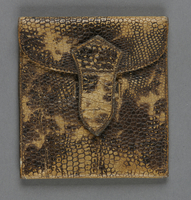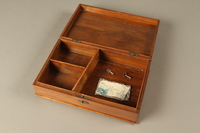Overview
- Description
- The collection documents the Holocaust-era experiences of the Schultz and Bodnar families, both of Hungary. The collection includes biographical material such as education, identification, and immigration documents; wartime correspondence between John and Edith (née Schultz) Bodnar in the United States and their families in Budapest; and pre-war family photographs. The collection also documents the death of Zoltan Schultz, Edith’s brother, who was killed on a death march to Mauthausen in April 1945, buried in a shallow grave, and reinterred in May 1945 by orders of the United States Army in a Catholic cemetery in Sankt Pankraz. Material includes documents, letters, and photographs found with Zoltan’s remains after he was killed and the Austrian police report regarding the disinterment.
Series 1 documents the Schultz and Spiegler families. Biographical material includes genealogy research; education, identification, and immigration documents; Edith Schultz’s autograph book and a personal narrative about her wartime experiences; Laura Schultz’s letter of protection from the Swiss Embassy in Budapest; restitution claims; documents, letters, and photographs found with Zoltan Schultz’s remains after he was killed and the Austrian police report regarding the disinterment; concert programs and sheet music of compositions likely written by Zoltan.
Correspondence includes letters written to Edith in the United States from Laura and Zoltan before he was sent to a forced-labor camp in 1942; letters to Edith from her friend Edit Laki who perished in the Holocaust; and letters from Laura written to Zoltan while he was in a forced-labor camp.
Photographs primarily contain pre-war photographs of the Schultz family as well as the Spiegler family (Edith’s mother Laura’s family). There is also a photograph of the Kilman family, who were friends of the Spieglers. Additionally, there are two photograph albums that primarily document the Schultz and Spiegler families. The albums contains several depictions of Zoltan’s time in a forced-labor camp in Nagykáta, Hungary.
The born-digital material contains audio, video, photographs, and a speech documenting Anita Skolnick (née Bodnar), Peter Bodnar, and Paul Bodnar’s 2015 trip to Austria to follow the path of Zoltan’s death march, receive his belongings from the Austrian government, and to unveil a memorial plaque at Mauthausen.
Series 2 documents the Holocaust-era experiences of the Bodnar family. Biographical material includes education, identification, and immigration documents; a catalog from Eugene Bodnar’s radio repair business; and genealogy research. Correspondence contains letters received and sent by John Bodnar in the United States. The bulk are letters received by his parents Eugene and Katherine, and his brother György and his wife Klári. Photographs document pre-war family life in Budapest. - Date
-
inclusive:
circa 1900-2015
bulk: 1916-1954
- Credit Line
- United States Holocaust Memorial Museum Collection, Gift of Anita Skolnick, Peter Bodnar, and Paul Bodnar
- Collection Creator
- Schultz family
Bodnar family - Biography
-
Laura Schultz (née Spiegler, 1895-1975) was born in Zagreb, Croatia to Ludwig (1859-1920) and Karolina Spiegler (d. 1921). She had five siblings, Theresa (1885-1964), Felix (d. 1941), Matilda, Irma (b. 1886), and Edward (Ődön); and one half-sister, Elizabeth (Erzsi).
Oszkár Schultz (1890-1935) was the son of Sandor (d. 1896) and Karolina (née Goldschmidt, 1860-1941) Schultz. He had two brothers, Lajos and Ferdo (Feri), and one sister, Erzsi.
Laura and Oszkár married and lived in Szombathely, Hungary. They had one daughter, Edith (later Edith Bodnar, 1920-2016), born on 1 July 1920, and one son, Zoltan (1917-1945). Oszkár died in 1935, and Zoltan, Edith, and Laura moved to Budapest, Hungary in 1936 after Zoltan was accepted to the Lizst Academy of Music. Edith immigrated to the United States on the SS Washington in 1939 under the Yugoslav quota, but Zoltan was on the Hungarian quota and unable to leave. Edith’s mother could have left under the Yugoslav quota, but chose to remain in Budapest with her son.
Zoltan pursued his studies in music as a violinist and conductor. Shortly after his graduation in 1942 he was sent to a forced-labor camp in Nagykáta, Hungary, and possibly to others. In April 1945, Zoltan and other forced-laborers were sent on a death march to the Mauthausen concentration camp. On 17 April, Zoltan and two others were shot and buried in shallow graves near Sankt Pankraz, Austria. His remains were disinterred on 22 May 1945 by orders of the United States Army and buried in a Catholic cemetery in Sankt Pankraz. A packet containing photographs, letters, and identifying documents was found when the body was exhumed. In 1968, the body was exhumed again under orders by the Austrian government to bury all unidentified Holocaust victims in a mass grave at Mauthausen.
Edith settled in New York and lived with her aunt Elizabeth Greene (née Spiegler) and her husband Joseph Greene. While there, Edith met John Bodnar, a recent Hungarian immigrant who was also renting a room from the Greenes. They married in 1942, and had three children, Peter, Paul, and Anita.
Laura remained in Budapest for the duration of the war. She received financial assistance from John’s parents, Eugene and Katherine, and lived with them in a “safe house” in 1944. They also provided Laura and Zoltan with letters of protection issued by the Swiss Embassy. She immigrated to the United States in 1946.
In 2015, Projekt Einhalt, a European research project on the death marches through the Steyr and Kirchdorf districts in 1945, discovered an Austrian police report regarding Zoltan’s death as well as a folder containing Zoltan’s belongings in an archive in Kirschdorf. Project Einhalt were able to track down Edith and inform her of their discovery about Zoltan’s death.
On Zoltan’s yahrzeit (23 April 2015), the Austrians performed a ceremony for Zoltan at the mass grave in Mauthausen, and traveled the death march route. In October 2015, Edith’s children Anita, Peter, and Paul visited Austria. They traveled the death march route, including Zoltan’s shallow grave after he was murdered, and placed a memorial plaque for Zoltan at Mauthausen. In Kirchdorf, they attended a ceremony where Austrian officials officially returned Zoltan’s belongings and the Austrian police report to the family.
John Bodnar (born János Bodnár, 1921-1985) was born on 19 March 1921 in Budapest to Eugene (born Jeno Krausz, 1883-1968) and Katherine Bodnar (born Katalin Hoffmann, 1888-1952). John had one brother, György (nicknamed Gyuri, 1913-2005). Eugene owned a radio repair store.
In 1939 Eugene and John visited New York to attend the World’s Fair. John remained in New York, but his father returned to Budapest. During World War II, Eugene had his Uncle Otto’s wife take over the store. He and his wife remained in their apartment, but had up to 64 other people living there when they were deported to the Budapest Ghetto where they remained for 12 days. After liberation, they discovered that their apartment had been turned into a hospital. Eugene and Katherine later immigrated to the United States. After Katherine died, Eugene married Edith’s mother Laura. They later separated and he moved back to Budapest.
John’s brother György was sent to a forced-labor camp in 1943 but survived the war. Oszkár’s brothers Feri and Lajos and his family perished during the Holocaust.
Physical Details
- Extent
-
5 boxes
5 oversize folders
2 oversize boxes
1 book enclosure
- System of Arrangement
- The collection has been arranged into seven series.
Series 1: Schultz and Spiegler families biographical material, 1917-1998
Series 2: Schultz and Spiegler families correspondence, 1921-1947
Series 3: Schultz and Spiegler families photographs, circa 1900-circa 1990s
Series 4: Schultz and Spiegler families born-digital material, 2015
Series 5: Bodnar family biographical material, 1917-1998
Series 6: Bodnar family correspondence, 1921-1947
Series 7: Bodnar family photographs, 1903-circa 1990s
Rights & Restrictions
- Conditions on Access
- There are no known restrictions on access to this material.
- Conditions on Use
- Material(s) in this collection may be protected by copyright and/or related rights. You do not require further permission from the Museum to use this material. The user is solely responsible for making a determination as to if and how the material may be used.
Keywords & Subjects
- Topical Term
- Jewish families--Hungary--Budapest. Jewish musicians--Hungary. Forced labor--Hungary. Restitution and indemnification claims (1933-) Emigration & immigration--United States. Jewish businesspeople--Hungary--Budapest. Death marches--Austria. Genealogy. World War, 1914-1918--Veterans. Holocaust, Jewish (1939-1945)--Survivors. Diplomatic and consular service
- Geographic Name
- Budapest (Hungary) Szombathely (Hungary) Nagykáta (Hungary)
Administrative Notes
- Holder of Originals
-
United States Holocaust Memorial Museum
- Legal Status
- Permanent Collection
- Provenance
- The collection was donated to the United States Holocaust Memorial Museum by Anita Skolnick, Peter Bodnar, and Paul Bodnar in 2017.
- Record last modified:
- 2024-03-05 10:42:33
- This page:
- https://collections.ushmm.org/search/catalog/irn559037
Additional Resources
Download & Licensing
In-Person Research
- Available for Research
- Plan a Research Visit
-
Request in Shapell Center Reading Room
Bowie, MD
Contact Us
Also in Schultz and Bodnar families papers
Documents, photographs, and correspondence, related to the experiences of Zoltan Schultz, originally of Budapest, Hungary, who was imprisoned by the Germans during World War II and killed during a forced march in Austria in April 1945. Material includes identification documents, and a packet of documents and photographs found with Schultz's remains when he was reinterred by personnel of the U.S. Army in late 1945, and retained by Austrian police officials until they were returned to Schultz's family in 2015, along with the original Austrian police report concerning the circumstances surrounding his reburial in 1945. Also included are photographs, documents, and and related materials concering the experiences of Schultz's extended family, including his sister Edith Schulz Bodnar, who had immigrated to the United States in 1939.

Change purse
Object

Wooden box, insert, two keys, and postcard wrapped in metal
Object
Wooden box with "Schz" inlaid on the top as well as a detachable wooden divider. There are two metal keys associated with it as well as a postcard wrapped in foil.



